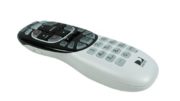In the last decade or so, we’ve been more or less deluged by blue LED lights. They appear on so many of our devices now, and even though we should be getting used to them, we aren’t. A lot of folks, myself included, find the bright blue LED to be the most piercing and most annoying LED there is. To understand why, we need to look at how LEDs work, and also how our bodies work.
What is an LED?
A light-emitting diode (LED) is just what it says it is: a diode that emits light. But, there’s so much more that we have to say. First, you have to understand what a diode is. A diode is an electronic component that only lets electricity pass one way. Diodes are a critical part of any electronic device. The first ones were giant fancy things in glass tubes, useful for amplification and conversion of electricity. The diode itself made radio reception possible, converting received electricity into a signal.
The diode itself led to the creation of the transistor, the component that makes computers possible. But diodes weren’t done just because transistors came in. Both have their uses. Because we really understand diodes well, and know how to manufacture them, we can use them for all sorts of things. One of those things is making light. If you have a diode that lets electricity come through in a predictable way, all you need to do is figure out how to convert that electricity into light. This is a problem that was solved in the 19th century with the invention of the electric light bulb, but diodes solve this problem with much more efficiency.
The good and the bad of LEDs
LEDs burn more brightly and use less power. But, they’re not perfect. LEDs only show a small part of the visible light spectrum. The color corresponds to the kind of metal used in them. Red LEDs were invented first, and a commercially practical blue LED wasn’t invented until the 1990s. The blue LED was critical because the red and green LEDs had already been invented. With those three colors, you can make virtually any other color.
Blue LEDs have an almost otherworldly look, because nothing in our natural world is the same color as a blue LED. They catch our attention instantly. And so, it was almost a given that they would find their way into our consumer electronics.
Blue LEDs and our bodies
Our eyes sense color through three kinds of sensors, called cones. The red and green sensors get a lot of work. Red cones are attuned to dangerous things like the sight of blood and the presence of fire. Green cones are attuned to determining whether our food is fresh. Blue cones… well they just fill in the space in the electromagnetic spectrum that defines what we can see. They provide a better picture of plants that give off UV reflections, but not a very good one. Most things in nature don’t overly stimulate our blue cones. However, our blue cones may have a very important use. By helping us determine day from night, and sunny days from cloudy ones, they may have helped our ancestors know how to survive.
Blue light tells our minds to be more alert, because we perceive blue light as something that happens when we’re supposed to be awake. That’s great if you’re a hunter. It’s particularly not great if you’re the kind of person who looks at their phone in the middle of the night. Blue light from TVs and monitors tricks our bodies into wanting to stay awake and alert.
Moving away from the (blue) light
More and more, doctors tell us to avoid blue light after dark. They believe we’ll be more rested and less stressed out if we do. That’s why most devices today have a “night light” option that changes our screens to an amber-brown tint. They eliminate blue to help our normal rhythms take hold. But, that doesn’t help all the devices with little blue lights.
I’ve tried a lot of different options to deal with those lights over the years. I’ve tried red nail polish as well as various tints designed for car windows.

My favorite, though, is Scotch brand 616 tape. This is a tape that was originally designed for commercial print shops. It’s a dark red tape designed to block the bright light used by printing plate machines. It works particularly well to block blue LEDs. It’s not cheap, though. A roll will probably last you your whole life, if that helps. You can find it at a lot of online stores.
No matter what you do…
try to mask off those blue lights. They aren’t worth the annoyance. Many new devices are cutting down on the blue lights. When you’re ready to upgrade to something without such a harsh blue light, make sure you shop at Solid Signal.





